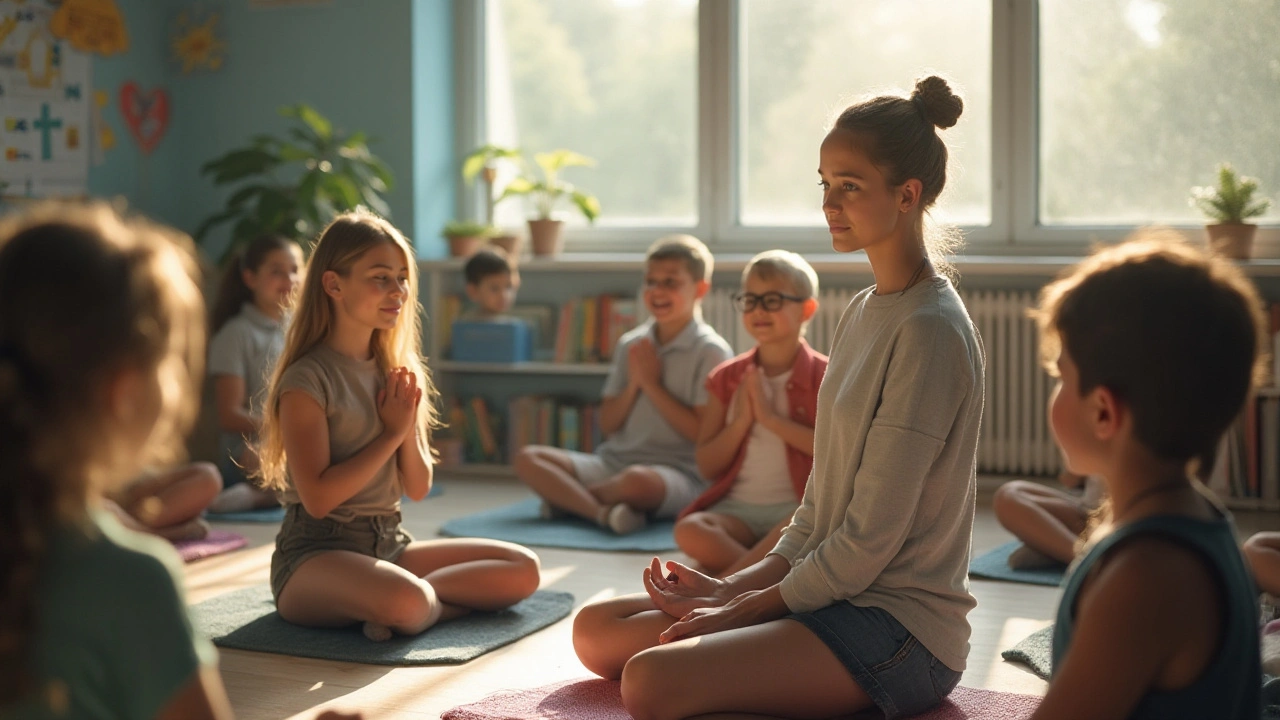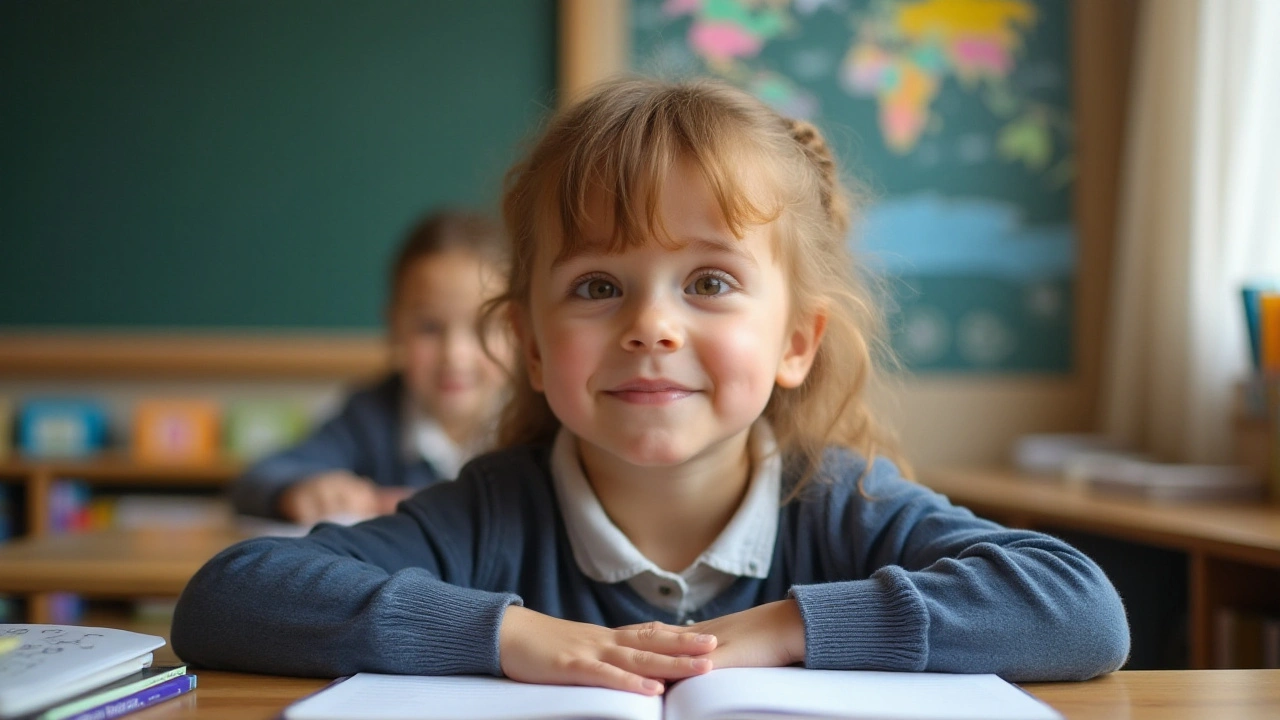
Meditation is becoming a significant buzzword in educational circles, and for good reason. Schools worldwide are exploring how integrating meditation can change the educational landscape. This practice, often associated with achieving personal peace, is bringing noticeable advantages to both students and teachers.
The inclusion of meditation in school routines is more than just a trend. It offers tangible benefits like enhanced concentration, improved mental health, and better academic performance. By weaving meditation techniques into daily school activities, educators aim to create a holistic environment where learning thrives and stress dwindles.
This article explores how meditation is proving to be a game-changer in education, offering practical tips and insights for effective implementation in various educational settings.
- The Rise of Meditation in Schools
- Benefits for Students
- Impact on Teachers
- Meditation Practices in the Classroom
- Tips for Implementation
The Rise of Meditation in Schools
The concept of integrating meditation into educational systems has gained substantial traction over the last decade. What started as a niche practice is now being embraced by numerous schools around the globe. The shift towards mindfulness in education isn't just a passing trend; it's an evolution aimed at addressing the diverse challenges faced by modern students.
One of the pioneering examples of this movement can be observed in the mindfulness programs adopted by public schools in the U.S. and U.K. West Point High School in Mississippi, for instance, has implemented a daily meditation session for its students. Similarly, several schools in the United Kingdom, like Monkseaton High School, have introduced mindfulness practices to help their pupils cope with academic stress.
The surge in popularity is not baseless. Numerous studies substantiate the positive impact of meditation on student well-being. Research conducted by the University of California, Los Angeles (UCLA) found that students who practiced meditation showed increased attention span, improved memory, and reduced anxiety levels. These benefits are pivotal in creating a conducive learning environment.
"By incorporating meditation into the curriculum, schools are equipping students with tools to manage stress and improve focus," says Dr. Laura Cousins, a renowned psychologist specializing in adolescent behavior.
A significant push towards this trend was observed during the COVID-19 pandemic. With the sudden transition to remote learning, students and teachers alike faced unprecedented levels of stress and anxiety. Meditation emerged as a key method to alleviate these pressures, with many educators incorporating mindfulness exercises into their virtual classrooms to combat Zoom fatigue and isolation.
The global rise in awareness about mental health has also been a catalyst for the adoption of meditation in schools. As societal norms evolve, there is a growing acknowledgment that education should nurture the mind, body, and soul. Countries like Australia are witnessing this change too, with schools in Brisbane and Sydney exploring meditation to enhance students' emotional and academic outcomes.
Parents' acceptance of these practices further propels their integration. Initially skeptical, many parents have come to appreciate the positive changes in their children's behavior and academic performance. Testimonials from parents whose children participate in school mindfulness programs often highlight improved emotional regulation and a calmer demeanor at home.
As the practice of meditation becomes more prevalent in schools, it's crucial for educational institutions to have trained professionals to guide these practices. Teachers and staff undergoing training in mindfulness can ensure the effectiveness and integrity of the meditation programs. In Sydney, for example, the New South Wales Department of Education offers professional development courses focusing on how teachers can incorporate mindfulness into their teaching strategies.
The rise of meditation in schools illustrates a broader shift towards holistic education. This approach is not just about academic achievement but also prioritizing the mental and emotional well-being of students. By equipping young minds with the tools to navigate the complexities of modern life, we are paving the way for a more resilient and mindful generation.
Benefits for Students
Introducing meditation in schools can be a game-changer for students. The hustle and bustle of daily school life, peer pressure, and academic demands often weigh heavy on young minds. However, meditation offers a respite, providing multiple benefits that support their overall well-being.
One of the standout advantages of meditation for students is the improvement in concentration and focus. Studies have shown that regular meditation can enhance attention span, making it easier for students to absorb information and perform better academically. When students meditate, they learn to clear their minds of distractions, which allows them to be more present and engaged in their studies.
Additionally, meditation is a powerful tool for managing stress and anxiety. School pressures can sometimes feel overwhelming, causing stress that hampers academic performance and personal development. Through consistent practice, meditation helps students develop emotional resilience, aiding them in better coping with stressful situations. In fact, a study conducted by the Journal of Positive Psychology reported that students who meditated experienced lower levels of anxiety and emotional distress.
Beyond mental health, meditation can also improve physical well-being. When students practice meditation, their bodies experience a reduction in cortisol levels, the stress hormone. This leads to better sleep patterns, which is crucial for adolescents who often struggle with sleep due to academic stress and screen time. Better sleep not only means better health but also translates to improved cognitive function during school hours.
Furthermore, meditation fosters a sense of empathy and compassion among students. By encouraging mindfulness and self-awareness, meditation cultivates an emotionally intelligent community where students are more understanding and supportive of their peers. This can lead to a more harmonious school environment, reducing incidents of bullying and promoting inclusivity. As noted by Mindfulness in Schools Project, meditation programs in schools often result in students being more considerate and empathetic towards each other.
According to Dr. Herbert Benson of the Harvard Medical School, “Meditation can improve a wide range of psychological and physical problems related to stress, demonstrating its vital role in enhancing students' academic and personal lives.”
A noteworthy point is the boost in creativity that comes with practicing meditation. When students meditate, they tap into a state of relaxed awareness, which is conducive to creative thinking. This can be particularly beneficial in subjects requiring innovative problem-solving and artistic expression. Regular meditation has been linked to enhanced imagination and the generation of creative ideas, enriching the learning experience.
The cumulative effect of these benefits is a significant boost in overall academic performance and personal growth. Meditation helps students develop a balanced approach to their school life, equipping them with essential skills for both academic success and personal well-being.

Impact on Teachers
It's often said that a teacher's well-being directly influences their students' experience. Amid the mounting pressures of modern education, teachers are discovering the rejuvenating advantages of meditation. This isn't just some passing trend; it's a well-documented benefit. The practice is carving out a path not only for student success but also for teacher well-being, thus creating a healthier school ecosystem.
Stress and burnout are common occupational hazards for educators. A 2023 survey by the Australian Principal Occupational Health, Safety and Wellbeing Survey found that 65% of teachers reported being highly stressed. This is where meditation steps in as a potent remedy. Regular meditation practice reduces stress levels by decreasing cortisol, the body's stress hormone. By lowering stress, teachers can become more present and engaged in their teaching roles.
"Implementing meditation practices for teachers has shown significant improvement in their overall well-being and job satisfaction," says Dr. Emma Seppälä, Science Director of the Center for Compassion and Altruism Research and Education at Stanford University.
Another substantial benefit is the enhancement of emotional regulation. Teachers who meditate are often better at managing their emotions, which helps maintain a calm and collected demeanor in the classroom. This emotional steadiness is not just beneficial for the teacher; it creates a ripple effect, fostering a stable and supportive learning environment for students.
Improved Focus and Cognitive Abilities
Just as meditation boosts students' concentration, it also sharpens teachers' focus. Numerous studies indicate that regular meditation enhances cognitive abilities, including improved attention and memory. Teachers report being more organized and effective in managing classroom activities, preparation, and even in the administration of assessments.
Beyond the classroom, these cognitive benefits can extend to teachers' personal lives, striking a balance that keeps them energized and passionate about their careers. This balanced state serves to reduce absenteeism, thereby maintaining consistent learning experiences for students.
Community and Collaboration
The positive impact of meditation isn't limited to individual teachers; it has a trickle-down effect on the entire teaching community. When schools adopt meditation practices, it often leads to improved staff relationships and teamwork. Teachers who engage in meditation together build a sense of community and shared purpose, making workplace dynamics more harmonious.
This enhanced sense of community extends beyond staff interactions. It filters into the student-teacher relationship, creating an educational environment brimming with mutual respect and appreciation. The sense of well-being permeates the school, fostering an atmosphere where both students and teachers can thrive.
Incorporating meditation doesn't need to be daunting. Here are a few practical steps schools can take to make it part of the routine:
- Start small with short, guided sessions during staff meetings.
- Offer optional meditation workshops or courses for interested staff.
- Create a quiet, dedicated space for meditation where teachers can go to unwind.
- Encourage peer support groups where teachers can share their experiences and techniques.
Through these simple steps, the benefits of meditation for teachers can be seamlessly woven into the school fabric, fostering an environment where both educators and students can excel.
Meditation Practices in the Classroom
Incorporating meditation into the classroom environment can seem daunting, but when properly integrated, it offers a calm, focused atmosphere. A popular practice is starting the day with a brief meditation session. This might be a simple 5-minute exercise where students close their eyes and focus on their breathing. It's a way of setting a peaceful tone that carries through the rest of the day.
Teachers can introduce more structured methods like guided meditation. These sessions may involve visualizing calming landscapes or repeating positive affirmations. For primary school students, guided imagery can be particularly effective. Storytelling coupled with relaxing guidance not only soothes but also sparks creativity.
Mindfulness practices are another excellent addition. These sessions usually encourage students to become more aware of their thoughts and bodily sensations. A mindfulness exercise could involve focusing on different parts of the body and relaxing each muscle. It is particularly beneficial for reducing anxiety and increasing emotional regulation.
Research from the American Psychological Association found that mindfulness in schools can reduce depression-related symptoms, lower stress, and improve school performance. Their findings show it also had a positive impact on students' physical health and overall well-being.
An emerging trend is using breathing exercises throughout the day. For instance, having a 'breath break' after recess or before starting a difficult exam helps students reset and approach tasks with a clear mind. Box breathing, where you breathe in, hold, exhale, and pause for four seconds each, is a simple yet effective method.
Some classrooms are adopting techniques like 'silent reflection periods' after lunch. This quiet time helps students shift their focus back to study after a busy lunch break. Teachers report improved attentiveness and better classroom behavior following these periods of silence.
Interactive apps and digital tools are increasingly being used. Applications like Headspace or Calm offer age-appropriate guided meditations. These apps make meditation accessible and engaging for students who are used to digital learning environments.
It's essential to create a dedicated space for meditation. A corner with soft cushions, calming music, and dim lighting can make students look forward to their meditation time. This area becomes a sanctuary where they can unwind and refocus.
Parents can take part, too, by encouraging meditation at home. Schools can send home simple exercises for parents to practice with their children. This reinforces the practice and helps establish a routine outside the classroom.
Integrating meditation practices into the classroom not only supports the emotional and mental health of students, but it also nurtures a learning environment where students feel safe, focused, and ready to learn. As schools continue to innovate, meditation stands out as a key element of modern education strategies.

Tips for Implementation
Introducing meditation into the classroom may seem challenging, but with a few strategic steps, it can become a natural part of the school day. Here are some practical tips to help educators and administrators get started:
Start with Small Steps
Diving headfirst into a full meditation program might be overwhelming. Instead, begin with short meditation sessions—just five to ten minutes at the start of the day. This makes the concept less daunting for teachers and students alike. Over time, these sessions can be extended as everyone becomes more comfortable with the practice. The simplicity of this approach helps ensure consistency and gradual acceptance.
Tailor to the Age Group
Different age groups require different styles of meditation. Younger children benefit from guided imagery where they imagine themselves in a peaceful place. In contrast, older students might prefer techniques focused on breath control or body scans. Tailoring the method to fit the age group ensures that students find the practice engaging and beneficial. This personalization enhances their overall experience and willingness to participate.
Create a Dedicated Space
A designated space for meditation can significantly enhance its effectiveness. This needn't be an elaborate setup—a quiet corner in the classroom with comfortable seating and minimal distractions can suffice. A dedicated space signals to students that this is a special, calm part of the day. Such a space can also serve as a retreat during stressful times, offering a sanctuary of calm amidst the hustle of school life.
Train the Trainers
For meditation to be successfully integrated, teachers need to be comfortable with the practice. Offering professional development sessions or workshops can equip them with the necessary skills and confidence. Schools can invite meditation experts to conduct these sessions, allowing teachers to experience the benefits firsthand. When educators are well-versed in meditation, their enthusiasm and understanding can significantly influence its adoption among students.
“The mind is everything. What you think you become.” – Buddha
Incorporate into the Curriculum
Meditation doesn't have to be an isolated activity. Integrating it into the curriculum can normalize the practice. For instance, incorporating meditation techniques into subjects like PE or health education can provide a holistic approach to student well-being. This interdisciplinary method reinforces the importance of mental health alongside physical health, creating a balanced educational environment.
Monitor and Evaluate
Regular monitoring and evaluation are crucial for understanding the impact of meditation on students. Collecting feedback from both students and teachers can provide valuable insights. Surveys, focus groups, or informal discussions can help identify what's working and what might need adjustment. This iterative process ensures that the meditation practice remains effective and responsive to the needs of the school community.
Engage Parents and Guardians
The success of meditation programs can be enhanced by engaging parents and guardians. Schools can organize workshops or informational sessions to educate families about the benefits of meditation. When parents are on board, they can reinforce the practice at home, creating a consistent and supportive environment for students. This community-wide approach helps sustain the meditation program and magnifies its positive effects.
| Grade Level | Preferred Meditation Type |
|---|---|
| Kindergarten - Grade 2 | Guided Imagery |
| Grade 3 - Grade 5 | Breathing Exercises |
| Grade 6 - Grade 8 | Body Scans |
| Grade 9 - Grade 12 | Mindfulness Meditation |
By patiently implementing these steps, meditation can become a natural, beneficial part of the educational journey. This approach promises not only to improve academic performance but also to foster a generation of mindful, balanced individuals.





